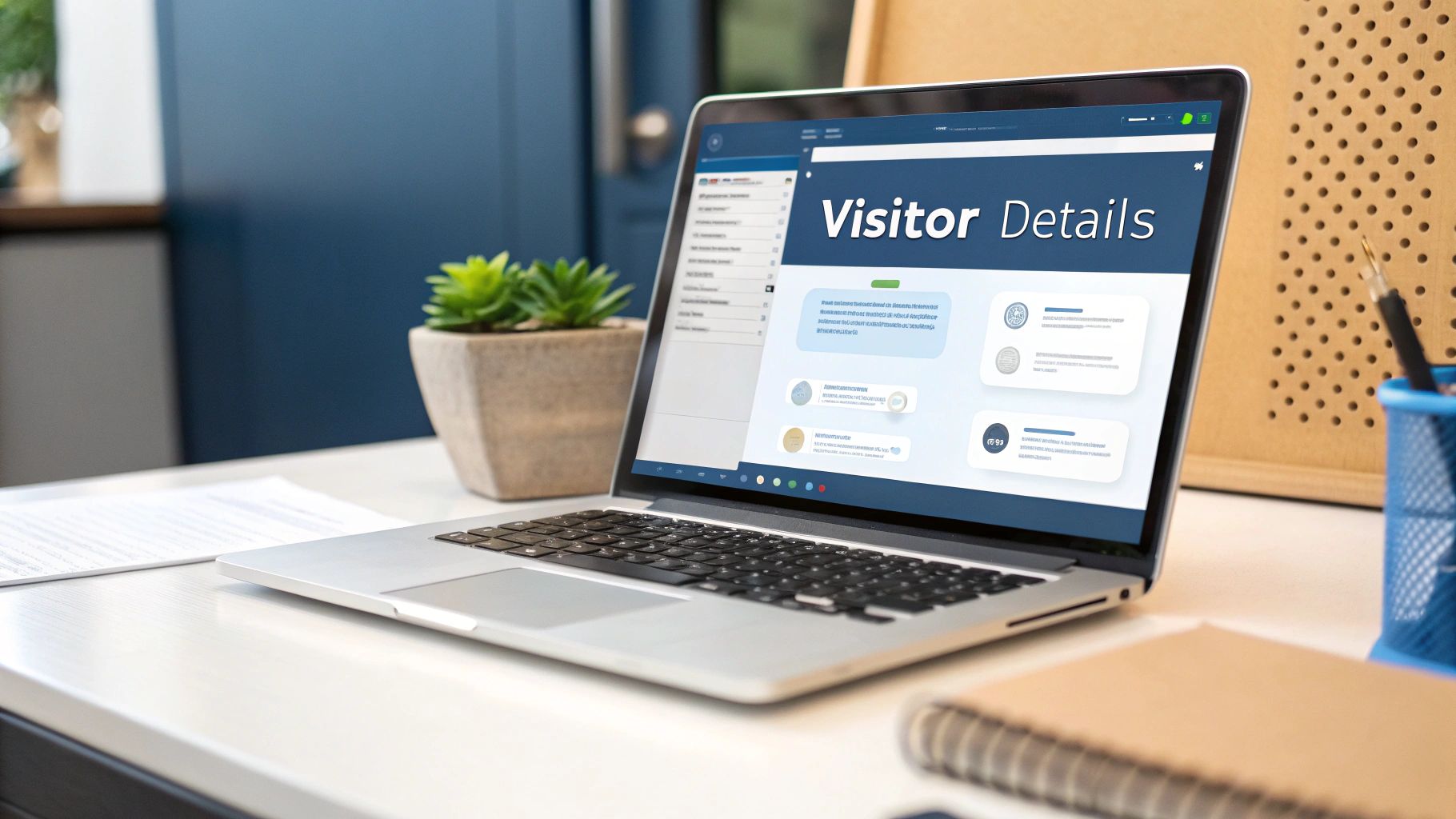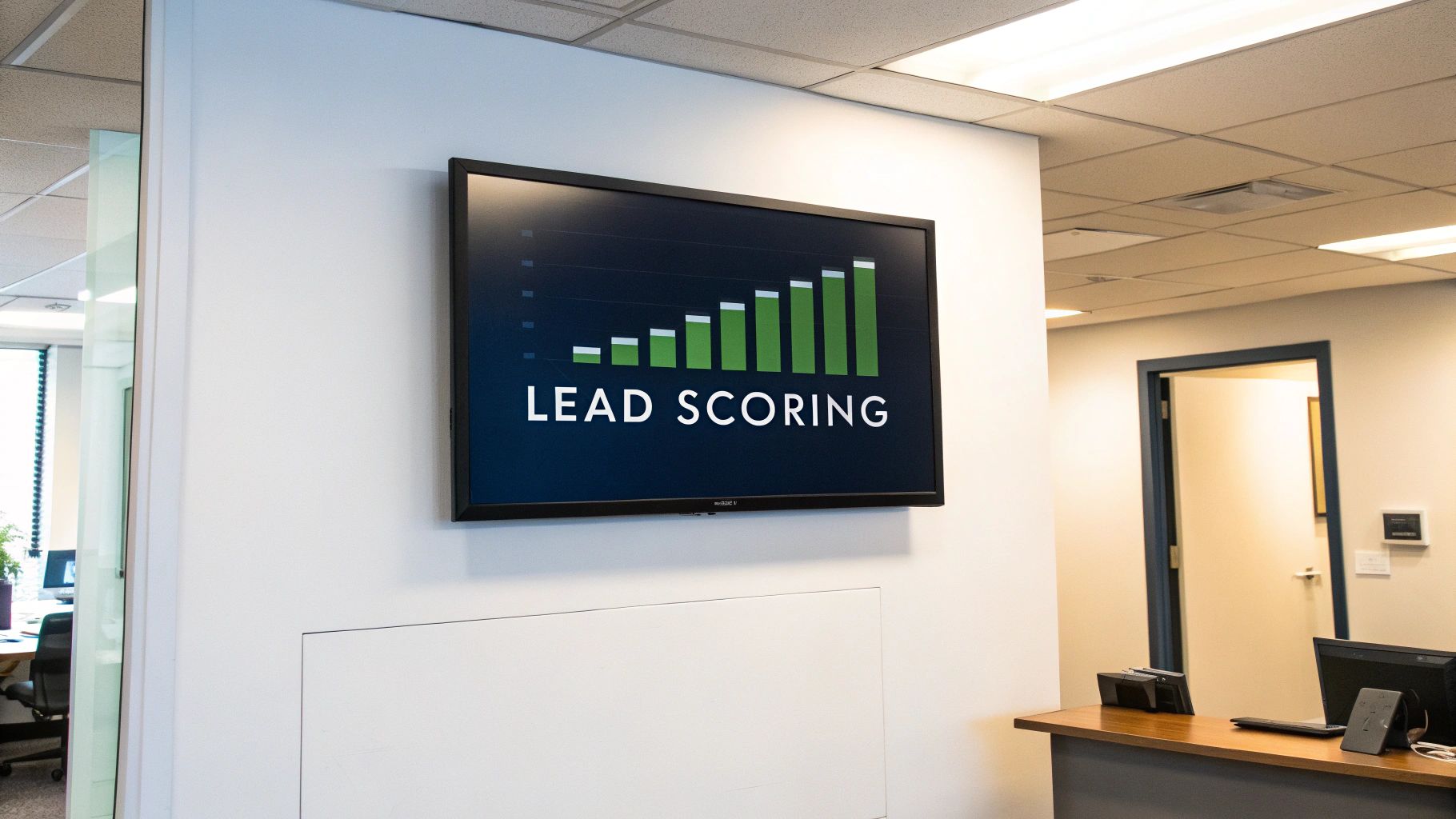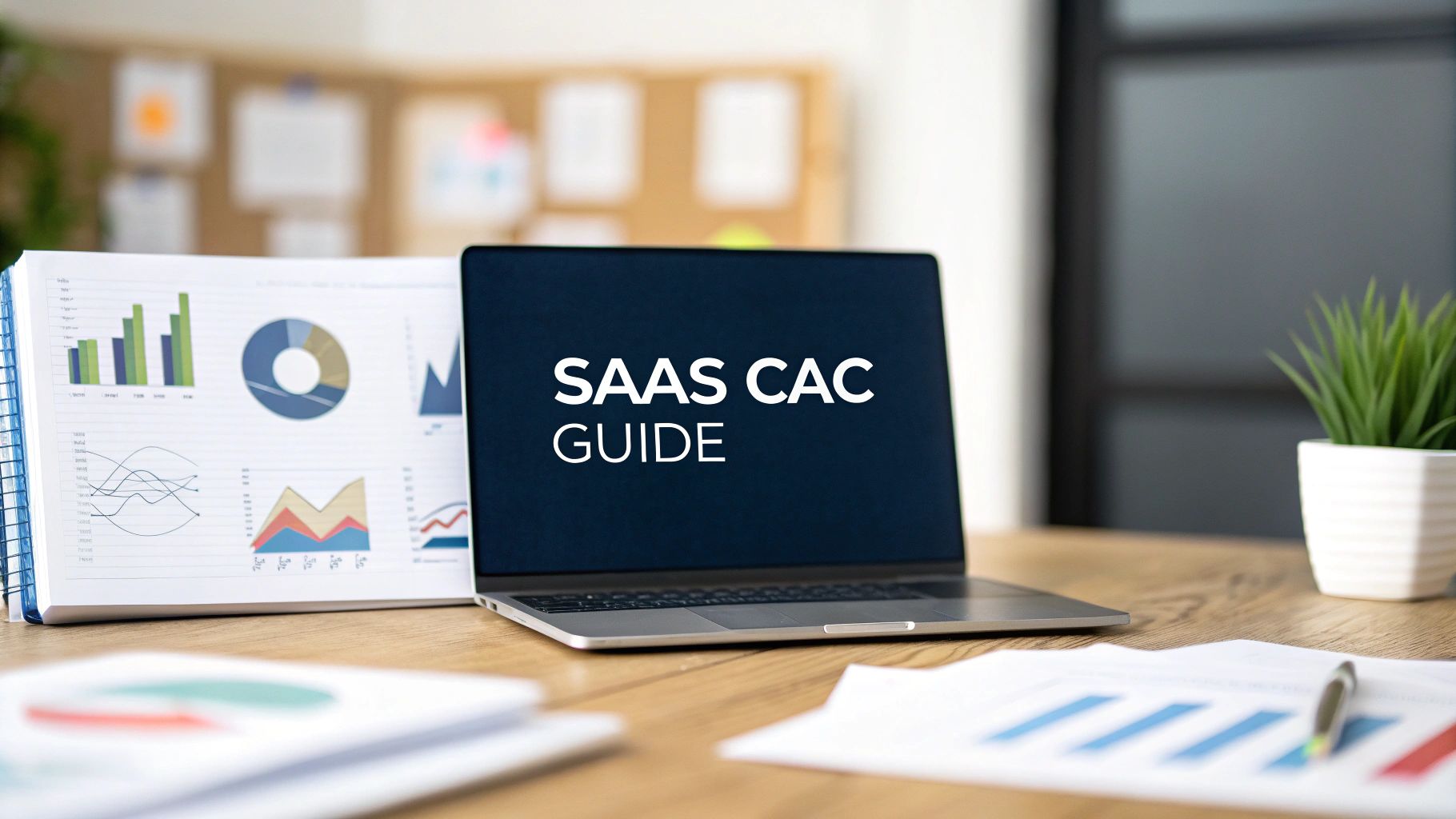How Do Chatbots Qualify Leads and Boost Sales? A Complete Guide
At its core, a chatbot qualifies a lead by turning a passive website visit into an active, two-way conversation. It’s on the job 24/7, asking smart, strategic questions to gather key information, figuring out a visitor's intent, and then seamlessly handing off the best prospects to your sales team.
Think of it as a dynamic, real-time screening process that never sleeps. By engaging visitors instantly, chatbots ensure no potential customer slips through the cracks, setting the stage for higher conversion rates and a more efficient sales cycle.
How Chatbots Qualify Leads in Practice
The old way of doing things—relying on static web forms—is quickly becoming a relic. Let's be honest, they’re passive, clunky, and people often give up halfway through. That gap between a visitor showing interest and your sales team actually responding can kill a deal before it even starts.
This is exactly the problem chatbots were built to solve. Instead of forcing someone to fill out a long, boring form, a chatbot engages them with one question at a time. It feels less like a chore and more like a helpful, guided conversation, which is crucial for modern lead qualification.
The Automated Qualification Workflow
The whole process is built for speed and efficiency, moving a prospect from "just browsing" to "sales-ready" without any human legwork. This flow is the secret sauce to a high-performing sales funnel.
As you can see, the chatbot acts as an intelligent gatekeeper, making sure only the most qualified, high-intent leads ever land on your sales team's plate. This frees them up to do what they do best: build relationships and close deals. For a deeper dive into the mechanics, you can read more about how chatbots qualify leads in practice.
The proof is in the numbers, too. Research shows that 33% of leads are willing to share their pain points and challenges directly with an AI chatbot, which is pure gold for qualification. This conversational approach can lead to up to three times higher sales conversions compared to a standard website form.
By automating that initial screening, chatbots don't just speed up the sales cycle—they significantly boost the quality of the leads. When a lead is finally handed off, they've already been vetted, scored, and are ready for a real conversation.
Chatbot Lead Qualification Stages At A Glance
To really get a handle on how chatbots qualify leads, it helps to break the process down into distinct stages. Each one has a specific goal, moving the visitor closer to becoming a qualified lead.
This structured flow ensures that every interaction is purposeful, guiding potential customers efficiently through your funnel.
Designing Conversations That Uncover High-Value Leads
The best chatbots aren't just data collectors; they're skilled conversationalists. The real secret to qualifying leads with a bot is designing a dialogue that feels natural and genuinely helpful, not like a robotic interrogation. You want to create an experience where visitors want to share the information your sales team needs.
It all starts with mapping out conversational flows that actually match different user journeys. Someone landing on your pricing page has a completely different mindset than a person reading a blog post. Your chatbot’s opening line needs to reflect that.

For example, forget the generic "How can I help you?". On a pricing page, try something like, "Trying to figure out which plan is the right fit? I can help you compare them." Right away, you're adding value.
Crafting a Natural Dialogue
A great script strikes a balance between being friendly and having a purpose. It needs to steer the user toward giving you key qualifying details without ever feeling pushy. This is where the magic happens—using structured questions and scoring frameworks to figure out who's ready to talk to sales.
We've found that asking targeted questions about business type, company size, and purchase timeline works wonders. It’s how you capture that crucial info smoothly, which is a world away from making someone fill out a clunky form. For a deeper dive into this, you can find some great chatbot efficiency insights at LegittmateAI.com.
The trick is to ask for information piece by piece. Start with easy, low-commitment questions before you get into the heavier stuff like budget or team size.
A well-designed chatbot conversation feels like a consultation. It builds trust by offering help first, making the visitor more comfortable sharing the details that are essential for qualification.
Real-World Script Examples
Let's look at how this works in practice for a couple of common scenarios. Pay attention to how the chatbot subtly weaves in questions to uncover BANT (Budget, Authority, Need, Timeline) details.
Scenario 1: SaaS Demo Request
- Visitor: "I'd like to see a demo."
- Chatbot: "Great! To make sure we show you the most relevant features, could you tell me a bit about your team? How many people would be using the software?" (Uncovering Need & Company Size)
- Chatbot: "Perfect. And are you exploring solutions for a project with a specific deadline in mind?" (Uncovering Timeline)
- Chatbot: "Got it. Who else from your team will be involved in the decision-making process?" (Uncovering Authority)
Scenario 2: E-commerce Product Inquiry
- Visitor: "Do you have this in blue?"
- Chatbot: "We do! Just to check, is this for a special event or for everyday use?" (Uncovering Need & Timeline)
- Chatbot: "Excellent. We have a few options in that category. Are you looking for something in a particular price range?" (Uncovering Budget)
In both examples, the bot is actively helping the user while gathering critical qualification data. This is how you turn a simple question into a genuine sales opportunity.
Using Lead Scoring to Identify Sales-Ready Prospects
It's one thing to collect information from visitors; it's another thing entirely to know what to do with it. The real magic happens when you turn that raw data into an actionable score, automatically telling you who's ready to talk and who's just browsing. This is where your chatbot becomes a powerhouse for qualifying leads, making sure your sales team isn't wasting time on dead-end conversations.
Think of it like a points system. You assign values to different pieces of information and actions. A Director of Operations from a 500-person company in your target industry? That's a high-value lead. An intern from a completely unrelated field? Not so much. The goal is to give each lead a score that reflects their potential.
Your chatbot is perfectly positioned to capture the two main types of data you'll need for this.
What They Tell You vs. What They Do
To build a solid scoring system, you need to understand the difference between explicit and implicit data.
Explicit Scoring: This is the straightforward stuff—the information a person gives you directly. Your chatbot can ask qualifying questions and assign points based on their answers. For example, if a lead confirms they have a budget of over $10,000, you might give them +20 points. If they say they have no approved budget, they get +0. Simple.
Implicit Scoring: This is all about behavior. You can't always ask someone about their buying intent, but their actions speak volumes. A chatbot, integrated with your website, can track things like which pages they've visited or how many times they've come back. Someone who has looked at your pricing page three times this week is showing far more interest than a person who bounced after reading one blog post.
A powerful lead scoring model never relies on just one or the other. It's the combination that tells the full story. A great job title is a good sign, but when that person also keeps coming back to your case studies page? That's a clear signal to get a sales rep involved, fast.
Choosing Your Scoring Framework
You don't have to reinvent the wheel here. There are several tried-and-true frameworks you can build your chatbot's scoring logic around. Instead of starting from a blank slate, you can adapt a proven model to your own sales process.
For a deeper dive into the different approaches, I'd recommend checking out these lead scoring best practices.
But to get you started, let's look at how a couple of the most common models compare when used in a chatbot context.
Comparing Lead Scoring Models For Chatbots
Different business models and sales cycles call for different qualification frameworks. This table breaks down two popular ones and where they shine.
As you can see, a model like BANT is incredibly easy to program into a chatbot's conversation flow. You can set it up to award +15 points if the person confirms they are the decision-maker, +10 points for a timeline within the next three months, and so on.
Once a lead's score crosses a specific threshold you've set—let's say 50 points—that's the trigger. The chatbot instantly knows this lead is qualified and can hand them off to a sales rep. This automated sorting and prioritizing is what makes the whole system so incredibly efficient.
Automating the Handoff to Your Sales Team
A perfectly qualified lead has a very short shelf life. The moment your chatbot flags a prospect as a hot lead, a timer starts, and every minute that ticks by diminishes your chances of closing the deal. This is where a smooth, automated handoff isn't just a nice-to-have feature—it’s a powerful competitive edge that directly feeds your bottom line.
The entire goal is to obliterate any manual work between the bot’s qualification and your sales team's first touchpoint. This transition is the make-or-break moment where a great bot conversation becomes a profitable human one. Any friction here is a potential deal-killer.

This is the real magic of using chatbots for lead gen: instantly bridging the gap between a sales-ready prospect and the person who can seal the deal. We know from plenty of research that getting back to a lead within five minutes can send conversion rates through the roof. With automation, that kind of speed becomes your standard operating procedure.
Creating an Instantaneous Connection
Your handoff has to be two things: immediate and packed with context. Your sales reps shouldn’t be scrambling to figure out who they’re talking to. They need the full story delivered on a silver platter the second that lead is deemed qualified. The only way to pull this off is by deeply integrating your chatbot with the software your team lives in.
CRM Integration: This is non-negotiable. The bot should automatically create a new lead or contact in your CRM, whether it’s Salesforce or HubSpot. All that valuable data the bot just gathered—from their budget and timeline to their company size—needs to be right there in the contact record.
Real-Time Alerts: Don't rely on someone checking the CRM every few hours. Set up instant pings in the tools your team actually monitors, like Slack or email. Imagine a dedicated
#hot-leadsSlack channel that instantly lights up with the new prospect’s details and a link to the full chat transcript. This simple setup can shrink your team's response time from hours to mere seconds.
This instant transfer of intelligence lets your sales team jump into the conversation warm and fully prepared.
A truly effective handoff is more than just a notification. It's about delivering the complete conversational context so your sales rep can pick up exactly where the bot left off. It feels seamless to the prospect and makes your team look incredibly sharp.
Triggering the Handoff with Precision
This whole system needs to run on clear, automatic rules. The most reliable trigger is the lead score we just talked about. As soon as a prospect’s score crosses a certain line—say, 50 points—the handoff sequence should fire without anyone lifting a finger.
Let’s walk through a real-world scenario. A visitor lands on your SaaS website and tells the chatbot they’re a "Marketing Director" (+15 points). They mention they need a new tool "this quarter" (+10 points) and that their team has "over 25 people" (+20 points). Their score is now 45 points—close, but maybe not quite ready for a sales rep.
But then, they navigate to your pricing page and ask the chatbot a specific question about your enterprise package. That single action could add another +10 points. The second their score ticks over to 55, the automation kicks in: a new opportunity is created in Salesforce, the #b2b-sales channel in Slack gets an alert, and the chatbot even offers to book a demo directly on a rep’s calendar. That’s how you turn interest into action.
Got Questions About Chatbot Lead Qualification? We've Got Answers
Even with the best game plan, you're bound to have some questions when you're getting a new system up and running. So, let's dive into some of the most common things people ask when they're looking to use chatbots for lead qualification. Think of this as the final piece of the puzzle to get you started.
How Does a Chatbot Actually Know if a Lead Is Qualified?
It might seem like magic, but it’s really just a smart, pre-programmed strategy. A chatbot isn't guessing; it's methodically following a set of rules you've given it, combining conversational scripts with a lead scoring system.
It all starts with asking the right questions. Many teams use a framework like BANT (Budget, Authority, Need, Timeline) to guide the conversation. As the bot gets answers, it assigns points behind the scenes.
For instance, a visitor who says they’re a decision-maker (Authority) might earn +15 points, while someone with an urgent problem to solve (Timeline) could get another +10 points. Once a lead's score hits a certain number you've set—let's say 50 points—the bot flags them as qualified and ready for sales. It’s a completely logical, data-driven judgment call that happens instantly.
Your chatbot is basically a tireless screener, applying your exact qualification criteria to every single person who lands on your site. It’s a system for finding the best prospects, and it runs with perfect consistency, day or night.
The really sophisticated bots take it a step further. They use Natural Language Processing (NLP) to pick up on conversational cues, sentiment, and even the specific words a person uses. This gives the bot a much more nuanced feel for a person's intent, making the whole process more accurate and surprisingly human.
Are Chatbots Going to Replace My Sales Reps?
This question comes up a lot, but it’s based on a common misconception about what these bots are designed to do. Chatbots don’t replace your Sales Development Reps (SDRs); they make them way more effective. Their real strength is in handling the high-volume, repetitive grunt work that can eat up a sales team's day.
Think about it: a chatbot can talk to every single person who visits your website, something no human team could ever do. It works 24/7 to sift through all the noise—the students doing research, the window shoppers, and the folks who just aren't a good fit.
This automated filtering frees up your skilled SDRs from the mind-numbing task of digging through low-quality contacts. Instead of wasting hours on dead ends, they can focus their energy where it really counts: building relationships and having smart conversations with people who are already warmed up and vetted.
- Chatbot's Job: Mass engagement and initial filtering.
- SDR's Job: High-value conversations and closing deals.
At the end of the day, the chatbot is the ultimate assistant. It works tirelessly to make sure your sales team’s calendar is packed with genuinely promising opportunities.
What’s the Real Difference Between Lead Generation and Qualification?
People often use these terms interchangeably, but they’re two very different stages of the sales funnel. Getting this right is the key to understanding how chatbots qualify leads so well.
A basic lead generation bot has one simple goal: grab contact info. It’s essentially a conversational web form that asks for a name, email, or phone number. Success is measured by how many new contacts it adds to your database.
A lead qualification bot, however, goes much, much deeper. It doesn’t stop at just getting an email address. It actively vets the lead to figure out if they’re a good fit and ready to talk to sales.
It does this by asking those crucial second-level questions that uncover real business intelligence:
- What’s your role over there?
- What’s the main problem you’re trying to fix?
- Is there a budget set aside for this?
- What’s your timeline for making a decision?
The qualification bot then scores the answers to these questions. This ensures that what gets passed to your sales team isn't just a long list of names, but a pipeline full of high-quality prospects who are genuinely interested in what you have to offer.
Ready to stop missing opportunities and give your sales pipeline the boost it deserves? Worknet.ai Inc offers an AI-powered chat experience built to qualify leads, convert more trial users, and support customers at every step. It’s time to build a more efficient sales process.
Find out more and get started at https://worknet.ai.
FAQs
.png)
Lorem ipsum dolor sit amet, consectetur adipiscing elit. Suspendisse varius enim in eros elementum tristique. Duis cursus, mi quis viverra ornare, eros dolor interdum nulla, ut commodo diam libero vitae erat. Aenean faucibus nibh et justo cursus id rutrum lorem imperdiet. Nunc ut sem vitae risus tristique posuere.
Lorem ipsum dolor sit amet, consectetur adipiscing elit. Suspendisse varius enim in eros elementum tristique. Duis cursus, mi quis viverra ornare, eros dolor interdum nulla, ut commodo diam libero vitae erat. Aenean faucibus nibh et justo cursus id rutrum lorem imperdiet. Nunc ut sem vitae risus tristique posuere.
Lorem ipsum dolor sit amet, consectetur adipiscing elit. Suspendisse varius enim in eros elementum tristique. Duis cursus, mi quis viverra ornare, eros dolor interdum nulla, ut commodo diam libero vitae erat. Aenean faucibus nibh et justo cursus id rutrum lorem imperdiet. Nunc ut sem vitae risus tristique posuere.
Lorem ipsum dolor sit amet, consectetur adipiscing elit. Suspendisse varius enim in eros elementum tristique. Duis cursus, mi quis viverra ornare, eros dolor interdum nulla, ut commodo diam libero vitae erat. Aenean faucibus nibh et justo cursus id rutrum lorem imperdiet. Nunc ut sem vitae risus tristique posuere.
Lorem ipsum dolor sit amet, consectetur adipiscing elit. Suspendisse varius enim in eros elementum tristique. Duis cursus, mi quis viverra ornare, eros dolor interdum nulla, ut commodo diam libero vitae erat. Aenean faucibus nibh et justo cursus id rutrum lorem imperdiet. Nunc ut sem vitae risus tristique posuere.
Lorem ipsum dolor sit amet, consectetur adipiscing elit. Suspendisse varius enim in eros elementum tristique. Duis cursus, mi quis viverra ornare, eros dolor interdum nulla, ut commodo diam libero vitae erat. Aenean faucibus nibh et justo cursus id rutrum lorem imperdiet. Nunc ut sem vitae risus tristique posuere.
Lorem ipsum dolor sit amet, consectetur adipiscing elit. Suspendisse varius enim in eros elementum tristique. Duis cursus, mi quis viverra ornare, eros dolor interdum nulla, ut commodo diam libero vitae erat. Aenean faucibus nibh et justo cursus id rutrum lorem imperdiet. Nunc ut sem vitae risus tristique posuere.
Lorem ipsum dolor sit amet, consectetur adipiscing elit. Suspendisse varius enim in eros elementum tristique. Duis cursus, mi quis viverra ornare, eros dolor interdum nulla, ut commodo diam libero vitae erat. Aenean faucibus nibh et justo cursus id rutrum lorem imperdiet. Nunc ut sem vitae risus tristique posuere.
Lorem ipsum dolor sit amet, consectetur adipiscing elit. Suspendisse varius enim in eros elementum tristique. Duis cursus, mi quis viverra ornare, eros dolor interdum nulla, ut commodo diam libero vitae erat. Aenean faucibus nibh et justo cursus id rutrum lorem imperdiet. Nunc ut sem vitae risus tristique posuere.
Lorem ipsum dolor sit amet, consectetur adipiscing elit. Suspendisse varius enim in eros elementum tristique. Duis cursus, mi quis viverra ornare, eros dolor interdum nulla, ut commodo diam libero vitae erat. Aenean faucibus nibh et justo cursus id rutrum lorem imperdiet. Nunc ut sem vitae risus tristique posuere.




.svg)


.webp)
.webp)
.webp)




